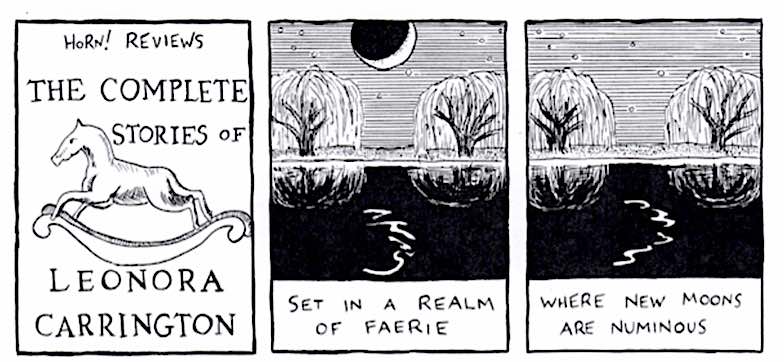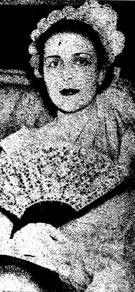Recent Articles and Reviews
The New York Review of Books March 8, 2018
In the Cauldron at Midnight
Regina Marler
One morning in Mexico City in 1991, the English Surrealist artist and writer Leonora Carrington and the art historian Whitney Chadwick set off for the Mercado de Sonora, a traditional market in a rough part of town that is also known as a mercado de brujería, or witches’ market. “It is here that the shamans and the curanderas [folk healers] find their supplies,” Carrington explained. After showing Chadwick [read more]
hyperallergic.com September 9, 2017
The Surrealist Satire of Leonora Carrington
These stunningly strange, arrestingly intellectual constructs treat the human imagination with humor and forgiveness.
Douglas Messerli
Despite the title of this beautiful book, The Complete Stories of Leonora Carrington, the author’s writings are not what most readers would define as traditional “stories.” In some way the works are similar to fairy tales, most focusing on speaking animals and magical creatures. But Carrington’s writings do not accord with the standard tales [read more]
Bookforum Sept/Oct/Nov 2017
Surreal Talk
The otherworldly, magical writing of Leonora Carrington
Porochista Khakpour
The mid-twentieth-century Spanish Mexican artist Remedios Varo once wrote a fan letter to Gerald Gardner, known in the UK as the “father of modern witchcraft,” in which she let him know that in Mexico City he was not alone: “I, Mrs Carrington and some other people [read more]
The Rumpus August 11, 2017
Horn! Reviews: THE COMPLETE STORIES OF LEONORA CARRINGTON
Kevin Thomas

nytimes.com July 28, 2017
New Sentences: From “The Complete Stories of Leonora Carrington”
Sam Anderson
Leonora Carrington kept a pet eagle, planted a tree in the center of her house and was once reportedly rescued from a mental asylum by a nanny in a submarine. She cooked her houseguests omelets that included their own hair, which she had secretly snipped off [read more]
New York Times June 2, 2017
The Romance and Heartbreak of Writing in a Language Not Your Own
Parul Sehgal
As a child, Leonora Carrington — painter, fabulist, incorrigible eccentric — developed the disconcerting ability to write backward with her left hand while writing forward with her right. This trick did not go over well with English convent school nuns. Between the world wars, Carrington was thrown out of one school after another for persistently odd behavior. When she came of age, she fled England [read more]
Artnews June 9, 2017
“It Was Very Clear I Was Possessed”: New Books Reveal Leonora Carrington’s Surreal Voice in Memoir and Fiction
Barbara A. MacAdam
One of the most intriguing features of Surrealism is that it plays havoc with time and place. The paintings of Leonora Carrington, who counted among the movement’s ranks before she died in 2011, could have been conceived in almost any historic moment and any locale inside or outside the imagination. Likewise, in her writings, Carrington’s evocations of madness, clarity of detail, and descriptions of internal terrors [read more]
Los Angeles Times May 5, 2017
Leonora Carrington, the surrealist storytelling genius you've never heard of
Joy Press
Painter and storyteller Leonora Carrington was the kind of wild, visionary character who ought to be emblazoned on our cultural memory. Instead, she's almost invariably relegated to footnote status, as a muse to Max Ernst and the Surrealists, a marginal figure in the grand narratives of other geniuses. [read more]
Broadly, vice.com April 12, 2017
The Forgotten Surrealist Painter Who ‘Didn’t Have Time to Be Anyone’s Muse’
Nel Dahl
By the time she was 30, the formidable painter and writer Leonora Carrington had had an affair with Max Ernst, endured a nervous breakdown, been forcibly installed in a mental institution, fled to Mexico, and written a harrowing memoir about madness... [read more]
The Village Voice April 12,2017
The Wildly Surrealist Stories of Leonora Carrington
April 6, 2017, marked the centennial of artist and writer Leonora Carrington’s birth. A British-born textile heiress who ran away from her parents, her inheritance, and bourgeois conformity to join the Surrealist carnival in Paris at the age of twenty, Carrington proceeded, like many iconoclastic Surrealist women, to build a legendary life around her own imagination. Although American biographers, art galleries, and museum curators have been raising. [read more]



